DC Comics biggest competitor, in the war comics market, was not Marvel, but Charlton. Marvel had, mainly, one war comic: Sgt Fury and His Howling Commandos. Charlton, depending on the period, had about a half dozen war comics, including Army War Heroes, Marine War Heroes, Army Attack, Fightin' Army, Fightin' Marines, Fightin' Air Force, Fightin' Navy, Dancin' USO, and War and Attack!
One of those might be made up.
Charlton didn't pay high rates and didn't put much money into production; but, they made up for it in volume and the stories were churned out by writer Joe Gill and artists like Charles Nicholas, Rocky Mastroserio, and Sam Glanzman. The bulk of their stories were set in WW2 or Korea; but, they started to include stories set in Vietnam and produced far more than DC; and, to be honest, did a better job at getting the details right. They also weren't shy about the politics of the war, referring to them as "Commies" and VC "terrorists." Charlton was a relatively conservative company, owned by an Italian immigrant, with some shady connections (possibly mob, though Dick Giordano denied this). It definitely followed the Vatican line that Communism was a threat to the Christian West.
As early as 1963, Charlton set stories in Vietnam, as seen in Army War Heroes #1, cover dated December 1963.

This first issue features a story, "The Rice Paddy War," uncredited but believed to have been written by Charlton workhorse Joe Gill and drawn by Bill Molno. A pair of American advisors and an ARVN squad have been air lifted to a sector, to hunt for Dhai Kang and his band ov VC. They encounter an ambush in the rice paddies and fight through, then work to set up their own ambush of Kang and his troops, catching them crossing a river feeding the paddies. They hit them hard and wipe out the VC and Kang, then return to their base.
This is fairly typical of actual missions in Vietnam, at this stage, with ARVN units and American advisors, hunting for VC insurgents. The US role is minimal, though they are commanding the Vietnamese troops and using helicopters to move in their troops. The weapons depicted are mostly Thompsons, for the two Americans and Ppsh 41 "burp guns" for the VC. It is a pretty basic story, lasting 5 pages. Nothing too political, nothing too fantastic. Basic war story, illustrating a typical battle, in that war. The other stories depict WW2, a one-pager about the ethnic diversity of America, and a short piece on Kit Carson.
Army Attack has several Vietnam stories, starting with issue #41....

A story, titled "Workday in Vietnam," features another American advisor leading an ARVN Ranger patrol, from Da Nang, on a hunt in the interior. The only problem with this is that the story begins at Tan Son Nhut Airbase, in Saigon, in the southern region of South Vietnam, while Da Nang is on the central coast, further to the north, closer to the DMZ. I suppose it could be a crack platoon, brought in specifically, but, logistically, it is all over the place. Regardless, the group is air lifted by helicopter to their area of operation and we see some basic airmobile tactics, as the helos sweep the area with machine gun fire and rockets, before landing their troops. We are still seeing Korean War Era helicopters; but, the tactics are correct, for the period. The team moves in, takes out a light machine gun position, in a tree, engages the enemy and locates bases and arms caches and destroys them, before heading home to Saigon.
Again, a basic story; but, not one that could have been a repurposed WW2 story, or even Korea, despite depicting mainly Korean War weapons. The ARVN carry M1 Garands and the American has the usual M-3 Grease Gun smg. He is depicted in camo utilities, which is a step in the right direction. Where it kind of falls apart is in the idea of a team operating from Saigon, then returning home, later in the day. Saigo was mainly command and support personnel, with field troops deployed in forward posts, conducting regular patrols in their sectors. You did have mobile strike forces (Mike Force), but those were reinforcements and shock troops, not hunter-killer teams, predominantly. Special Operations Group ran teams like that; but, usually from forward areas. Saigon was about as "rear" as it got. There were terror attacks in the city; but, Charlie ruled the countryside, which is why troops were deployed there.
Both of these stories present the idea that American-led troops are unbeatable in the field and the VC will cut and run when hit by them. The next entry, from issue #43, tells a different story....

A patrol is hit by a VC attack and they are shot to pieces. They call in a medevac and get their wounded out a return to base, with tails between their legs....
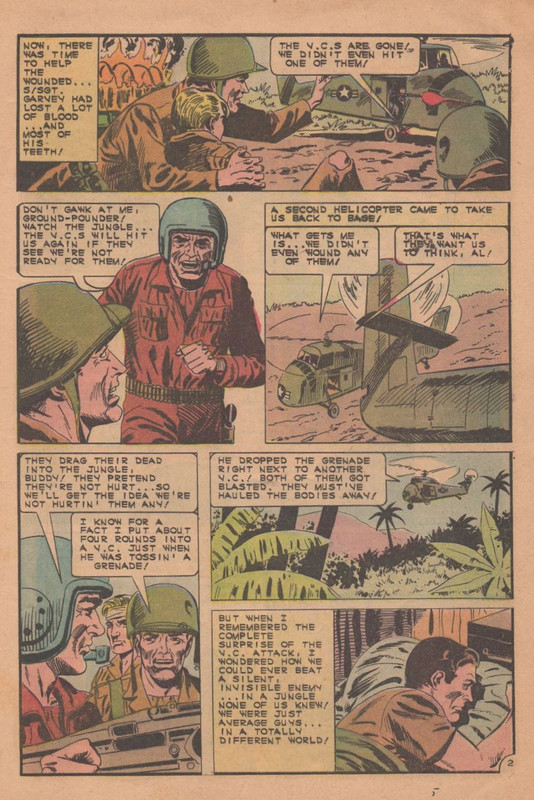
Soon, the VC hit their base and hit it hard; but, our narrator stats fighting back and soon loses his fear of the VC, replaced by anger and a desire for revenge. The next time they meet in the field, they hold off the VC, but the narrator is bit by a venomous spider. After treatment, he wants back in the fight. The enxt time they meet the VC, they take the initiative and wipe them out.
This is the first story, so far, to treat the VC as a formidable enemy, with a reputation that causes men to fear them. However, this could have been easily set at Guadalcanal and been the same story, minus the helicopters. The Japanese had an invincible reputation, based on their initial movements in the Pacific and the loss of the Philippines. Guadalcanal was the first time that new troops met them in comba, in fierce fighting. Like the narrator, the soldiers and Marines had to overcome their fear of the Japanese reputation and see them as men, just like them, who could be beaten.
Issue #46 is almost entirely a Vietnam issue.

The opening story, "The Enemy Within," is set at a Special Forces camp, where the Green Berets and their Montagnard CIDG strikers face an enemy attack on their base....

They repel the attack and wait for ARVN reinforcements to arrive, before nightfall, when the VC will try agin. The group arrives, but something isn't right, as an ARVN
dai uy (captain) salutes the American lieutenant and calls a corporal, "sergeant." He also doesn't raise a fuss when said corporal denies him the use of their transmitter, saying only he can send messages on it. They smell a rat and sure enough, the ARVN troops are VC infiltrators. The Montagnards had also smelled a rat, though the story makes a point of highlighting the racial hatred between the montagnards and the Vietnamese, North or South. They are able to fight off the enemy attack and take out the infiltrators.
This story, credited in GCD to Joe Gill and Sam Glanzman, shows some actual research. The camp is set up much like a real camp, with earthen, timber and sandbag bunkers and gun emplacements, earthen defensive walls, concertina wire and huts. The soldiers are armed with M-14 rifles, with correct flash supressors and magazines and Glanzman knows how to draw a military beret and even positions the insignia correctly. He draws jungle utilities of the era, though he gets the angle of the pockets wrong, as he draws traditional utility pockets, but the Vietnam upper pockets were slightly slanted. The .30 cal machine gun position is correct and Glanzman draws a soldier feeding the ammo bel to the machine gun, while the corporal fires it. We later see a mortar pit, with sandbag retaining walls and an emplacement for a recoilless rifle, which is also drawn correctly.
Sam did his homework!
The next feature is "Is This Hat For You?," which reads like a recruitment pamphlet for Special Forces.....

It talks about the selection and training and qualifications to earn the Green Beret and then the actual missions they carry out, in Vietnam, like recruiting and leading a montagnard CIDG unit, providing medical care to the village and their families, capturing and interrogating prisoners, carrying out patrols, and living and eating with the natives.
That is followed by another piece on the training and skills of the Green Berets. Then, a dramatic piece about a Green Beret, called Col. Muggsy Martin, who is hunting Chinese advisors to the VC, finds himself captured. Special Forces move in Mike Force troops and paradrop others and call in air strikes and route the VC, freeing the colonel. In the course of things, then Chinese advisor refers to the National Liberation Front (the VC's official name). It does refer to the Chinese advisor as a "terrorist," while ignoring the fact that he is doing the same job as the Special Forces soldiers: advising his ally in fighting the enemy.
Issue #47 features another story, where an ARVN captain turns out to be a VC and is discovered and captured. That is followed by a story about Air Cav troops, who have dug into a position, for a period of time, before moving on.
Through all of this, we see proper weapons and more period-correct uniforms and equipment. The Muggsy Martin story depicts the Green Beets as carrying M-16s, while the earlier pieces have the M-14. This issue was released in late 1966 (cover dated December), when the M-14 was being replaced by the M-16. Glanzman draws Hueys and the next issue features CH-47 Chinooks, while DC and Marvel are still depicting Choctaws. It's pretty embarassing that a low rent company like Charlton was showing up the big guns, at DC and Marvel, though the quality of the art at DC and Marvel was better, due to the higher pay. Glanzman is an excellent artist, as was Charles Nicholas; but, the low pay and need for more work meant they compromised on finesse and focused on speed, so their work is less finished than Glanzman's USS Stevens or Haunted Tank stories, at DC.
Glanzman was the artist, along with writer Will Franz, on the feature, The Lonely War of Captain Willy Schultz, in Fightin' Army. However, the onyl recurring feature about Vietnam was over in Fightin' Marines. So we will head there, next, after a brief look at the Marine presence, in Vietnam.
The US Marine Corps had long been the United States' main expeditionary force, called up any time they needed to send troops to foreign soil. From the Halls of Montezuma, to the Shores of Tripoli is not just a lyric of the Marine Hymn, it is an illustration of their history:
From the Halls of Montezuma To the shores of Tripoli;
We fight our country's battles In the air, on land, and sea;
First to fight for right and freedom And to keep our honor clean;
We are proud to claim the title Of United States Marine.
Our flag's unfurled to every breeze From dawn to setting sun;
We have fought in every clime and place Where we could take a gun;
In the snow of far-off Northern lands And in sunny tropic scenes,
You will find us always on the job The United States Marines.
Here's health to you and to our Corps
Which we are proud to serve;
In many a strife we've fought for life
And never lost our nerve. If the Army and the Navy
Ever look on Heaven's scenes,
They will find the streets are guarded By United States Marines.
9 out of 10 sailors couldn't give you the complete lyrics to Anchors Away; but, every Marine can recite the Marine Hymn.
The Marines were first deployed to Vietnam in 1962, when the USMC Task Unit 79-3-5 was sent to provide air cover for MACV operations. Then, in 1965, the 9th Marine Expeditionary Brigade was deployed to Vietnam, with two battalions. One executed an Amphibious landing, near Da Nang, while the other was air lifted, demonstrating the capabilities of the US Marines. They were the first major combat unit deployed to Vietnam, in force, rather than smaller elements, like the A-Teams of the 3rd and 5th Special Forces groups. Their area of operations was I Corps, in the central part of Vietnam, near the DMZ. They provided support for Fire Bases, airfields, and provided patrols, while operating in and around Quang Tri province, from Da Nang, Dong Ha and Hue. They were expanded into the III Marine Amphibious Force, consisting of the 3rd Marine Division and 1st Marine Aircraft Wing.
One of the chief Marine areas of operation was around the combat base, at Khe-Sanh. In 1967, the base came under attack by the PAVN and they fought them back; but, in 1968, during the Tet Offensive, the base came under siege and was cut off, forced to resupply from the air. Unlike the French, at Dien Bien Phu. the air drops were more successful in getting supplies and ammunition on target. C-130s would land and unload, but were targeted by rockets; so, they switched to coming in low, at speed, and deploying drag chutes, which yanked out cargo sleds with pallets of supplies, which the Marines then grabbed and desibursed where needed. They were able to keep up these missions as they brought reinforcements in via helicopter and hit the PAVN artillery sites, until they were able to mount a counter-offensive to clear the roads to Khe-Sanh and bring in greater numbers of troops and supplies and start offensive operations to push the PAVN out of the area, which was successful.
At Hue, Marine Task Force X-Ray fought their way to the Military Assistance Command HQ and retook the compound, forcing the PAVN and VC out, before eventually securing the city and breaking the back of the VC insurgents. Much of the news reporting during the Tet Offensive focused on the initial attacks and the chaos created, with images of desperate firefights. What didn't get shown was the fighting to relieve the besieged defenders and the decimation of the insurgents and PAVN support troops. Also generally left out of the reporting was that the VC infiltrators had enemy lists, targeting civilians for assassination, where some 3,000 were killed in Hue, alone. These were political targets, often teachers and civic leaders, rather than military personnel or government officials. The images sent out during the Tet Offensive had a major effect on morale at home and did much to tilt public opinion into the anti-war side, emboldening the protests. It didn't mark the end; but, it did mark the shift in the tide of the US commitment. Vietnam was the centerpoint of the 1968 election, which was won by Richard Nixon. Nixon then escalated US combat actions in Vietnam, with B-52 bombings of Hanoi and other parts of North Vietnam, before eventually drawing back on troop commitments, starting in 1970. The US began turning more and more responsibility for fighting the PAVN and VC to the ARVN, with US air support. The Marines were reduced to an air presence, by 1972.
During the course of the war, the Marines ran the Combined Action Platoon program (CAP), where Marine officers and NCOs lived and trained with the Vietnamese, in their villages, in a "hearts and minds" campaign, to get the people to trust the Marines and aid them with intelligence about VC movements. Generally speaking, the Marines were more successful at these types of programs than the Army, though they fell short of their long term goals. The program ran until 1969, when they were curtailed with the drawdown of troop levels. The Marines would revive these types of programs in Iraq and Afghanistan, during the War on Terror, proving more effective in earning the public trust than the Army Airborne.
In 1968, Fightin' Marines introduced the regular feature, Shotgun Harker and The Chicken, starting in the 78th issue.

The comic features a pair of earlier stories, set in Vetnam, with a Pacific Theater veteran Marine, returned to duty in Vietnam, after his son is deployed there; and a second about a group of Mariens, tasked with helping a VC defector escape, with his daughter. In both cases, the Marines are drawn rathe like Army soldiers and there is no real identification as Marines, except in the opening story, where the Major is shown at Tarawa and Iwo Jima and the narration says he was leading Marines. His uniform does not include the Marine camouflage helmet covers and it has rank insignia on it, which the Marines did not use, for fear of sniper's targeting officers and NCOs. More than likely, these stories were done to be used where needed, with captions altered to identify them as Marines or Army. When we see the Major in uniform, it is the sevice green of the Army and not the distinctive Marine Corps green uniform, let alone th Dress Blues.
Next, we meet Sgt Arkie Harker, aka "Shotgun," with the 3rd Squad, second platoon, Alpha Company, on patrol, when an FNG (Foolish New Guy, according to the captions; but, I can assure you the F stands for something else) nearly walks into a burst from a light machine gun. Harker fires his double barrel shotgun into the enemy, despite the captions saying it is an autoloader. Harker saves the bespectacled kid, who bemoans being stuck by a "hero," and he just wants to make it out alive.....
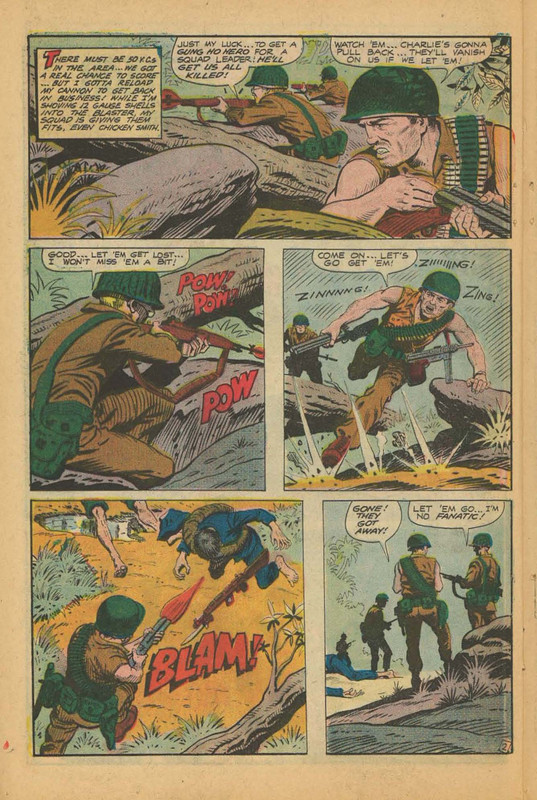
The kid is Chicken Smith and he does his job, but he doesn't go looking for chances to be a hero and promised his mother to die of old age. The VC disappear down a tunnel and Harker is too big to fit; so, Chicken gets to, reluctantly, play tunnel rat. The rest wait above and hear a loud WHUMP, then Chicken sticks his head up and says be prepared, because he chucked in two white phosphorus grenades (Willy Peter) and a lot of stuff is going up. Next come a bunch of VC, to surrender.
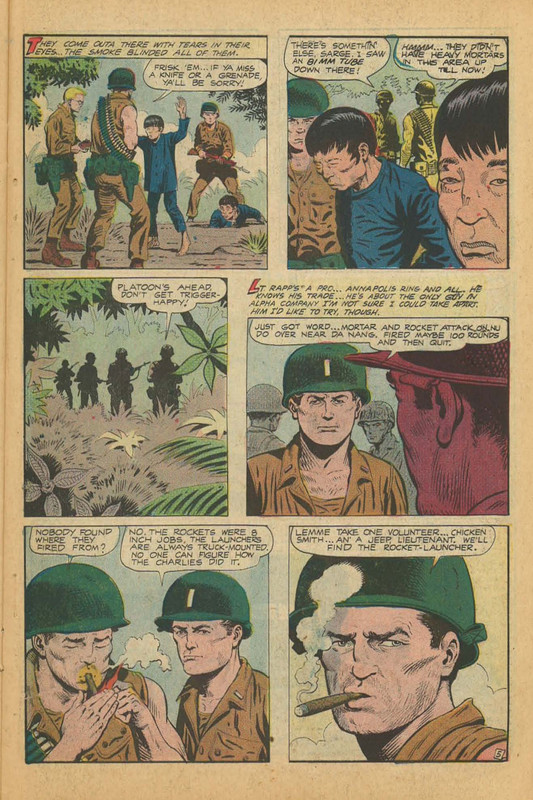
They turn the prisoners over to the platoon, as Smith says he saw an 81mm mortar tube down there, which hasn't been heard of, in the area, before. The platoon commander tells them of a mortar and rocket attack and Harker requests permission to take a jeep and Chicken Smith to locate the mortar team. The request is granted and Chicken finds himself dragooned into the plan. Harker has a hunch about how the VC infiltrated the area and they shadow an ARVN convoy. A soldier on a truck salutes Harker and he tells Chicken to follow them. He definitely knows they are phonies when they don't hoot and holler at a young lady walking past them. The VC get nervouse and bring up a bazooka, which hits the jeep, but not before the two Marines bail out. They follow on foot and locate the mortar team and sabotage their bombs, so that they go off early, blowing up the mortar tubes and the rocket launchers, parked beside them.
The heroes return to base and then get passes to Saigon, as a reward. Harker drags Chicken out, as he pleads that he is tired and has a girl back home....

The stories generally follow this formula of Harker drafting Chicken into helping him on some special mission, while Chicken complains, yet always does his share of the fighting. The feature began in late 1967 (cover dated January 1968) and continued through issue #108, in 1972 (cover dated January 1973), which is when the US was largely pulling out of Vietnam. Bill Montes is the main artist early on, though Sam Glanzman handles it for a while, before it finishes up with Charles Nicholas. Montes has a lighter touch with things, though Glanzman can match him and is more accurate with the details. Nicholas is a bit more perfunctory.
Two issues of note are #90 and 92.


#90 features a story where Shotgun is angry at an artillery spotter plane, for giving away their position, then the plane gets hit and goes down. Shotgun and Chicken make it to the plane and rescue the pilot, getting him out before the VC can get to him. Large numbers start moving in and the pilot, who had radioed for a helo, sends in new requests for a Magic Dragon and/or some "sports cars." Harker and Chicken take up positions and try to hold off the VC, while the pilot retrieves papers from his downed plane, which could provide intel to the enemy. He radios in a request for a "basket" and we see another Cessna spotter plane come in, with a wire basket on a line. The pilot puts the papers in there and the pilot snatches it away, leaving them on the ground. Harker gripes about the Zoomies, until we see a AC-47 Spooky, fly in and Puff the Magic Dragon activates it's 7.62 mm GE mini-guns and sprays death upon the VC below....
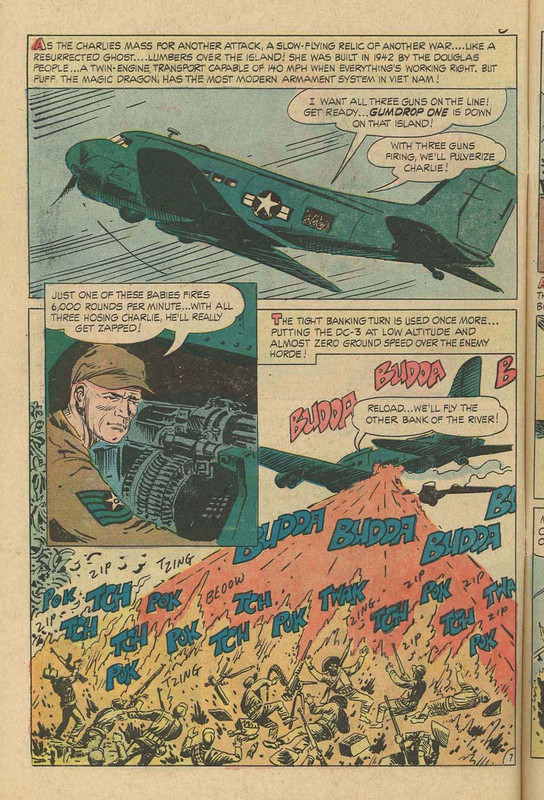
This is soon followed by the "sports cars," F-5 Tiger II fighter-bombers, who drop more ordinance on the VC, allowing the pilot , Shotgun and Chicken to escape. They move out and learn that the pilot is General Joe Smith. He's the reason why the VC are so determined to get to a lone spotter plane. They move out and make it to an LZ, where a CH-47 Chinook comes in to pick them up and take them to safetu, while the general makes cracks about Shotgun's earlier disparaging of the Air Force.
The story is too early to be influenced by the event; but, it is reminiscent of the BAT-21 mission to rescue USAF Lt Col Iceal Hambleton, a navigator on an EB-66C/E Destroyer flight, who was foced to eject when the plane was hit. Hambleton had extensive knowledge of missile and electronic warfare operations in Vietnam and was a valuable prize. He was the only one of the three aircrew to safely eject and the hunt for him was extensive. After 5 aircraft and 11 aircrew were destroyed or killed, in rescue attempts, the Air Force ceased Search and Rescue missions to reach him and, instead, hit upon the idea to guide Hambleton via code, to an extraction point, where he would be met by a rescue party, who would get him to safety. He only had his bail out radio and it was not encoded. So, they concocted a scheme to give him direction and distances to travel, based on specific holes at various golf courses where Hambleton, an avid golfer, had played. The distances and directions corresponded with the layout of those holes, at specific courses. They relayed the information, on open channels, which told him where to move, but gave no clue to radio interceptors. He was able to get to the rendezvous point, where US Navy SEAL LT Thomas Norris and Vietnamese VNN commando Nguyen Van Kiet met him and got him to safety. Norris was awarded the Medal of Honor for getting Hambleton out of enemy territory, in 3 nights of travel.
Issue 92 features a story of hippie philosophy creeping onto the battlefield and into Chicken's head. We see Chicken and Shotgun engaging the enemy, Harker with the butt of an M-16, Chicken with a peace sign....

Shotgun shakes him out of it. He's wearing love beads and flowers and talks about a brother in enlightenment who gave them to him. They then hear, over the radio, an American claiming to be with the VC. The American identifies himself and says there are two other Americans, who have offered their lives to protect the VC from air attack. Harker tells the platoon commander to stall, then "entices" Chicken to lead him to the peaceniks.
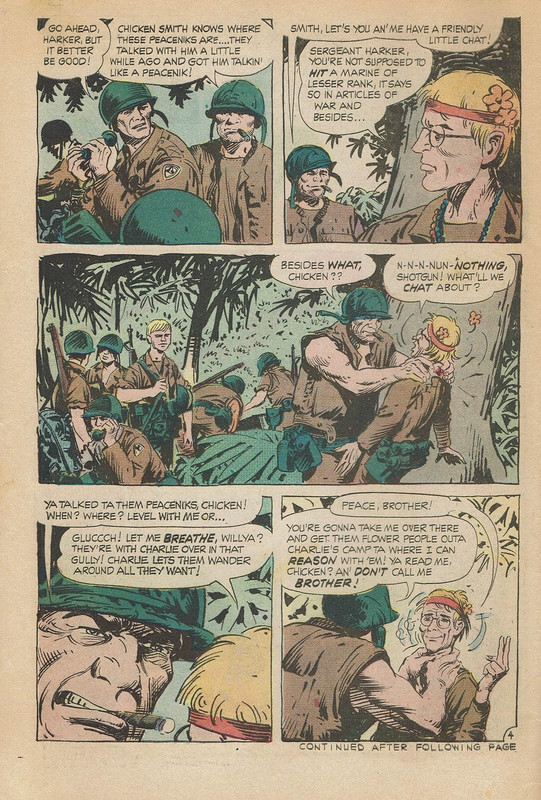
Chicken leads him to the peaceniks, who say that Mildreth went to a nearby village, to see a Peking newspaperman. They follow and find Mildreth with the VC, as they kill a village chief and set fire to the village, as he protests. Shotgun and Chicken rescue Mildreth and chase off the VC, then arrest the three and force them to march back to camp, while Chicken puts his boot up the backside of one of them, as he appeals for peace and love.
This is a definite political story, as Joe Gill openly mocks the peace movement and anti-war activists. between 1965 and 1972, some 300 American activists visited Hanoi and North Vietnam, seeking to bring an end to the conflict, including Jane Fonda, in 1972. The visits were used as propaganda by the North Vietnamese, to show a lack of support for the US effort, at home, while the US media largely ignored any information that the activists brought back, suggesting the bombing of civilians, rather than military targets. The activists were usually well-meaning, but woefully naive and the media was more interested in painting them as traitors to their country, rather than idealists who had little grasp of how their actions were used against US POWs and others and to deflect attention from atrocities committed by the VC and PAVN. At the same time, the media largely ignored those committed by the South Vietnamese government against its own population and the lack of any coherent strategy from the military and defense Department.
The Hippie and peace movement of the 60s was part of a larger counter-culture that was going on globally, as the Baby Boom Generation came of age and launched protests about the state of their countries. In May 1968, French students took to the streets in violent protests over lack of economic opportunities. Students in Warsaw demonstrated against the Polish government, after it banned a play with anti-Soviet references. In Czechoslovakia, protesters launched the Prague Spring, non-violent protests against the Soviet invasion, after they tried to shut down Alexander Dubcek's attempts to liberalize the government. Students also marched in protest against the Tito government, in Belgrade, in Yugoslavia. Russian activists tried to protest the Czech invasion, in Red Square, and were beaten and dragged off. Protests in the US occurred all over, from anti-war protests on campuses to a protest of Dow Chemicals, the manufacturers of napalm. The 1968 Democratic National Convention, in Chicago, was the scene of riots, as protesters clashed with Mayor Richard J Dailey's police force, resulting in the Chicago 7 Trial. Student protests occurred in Brazil, Italy, Mexico and Pakistan. Japanese activists protested the Vietnam War. Anti-Apartheid Protests occurred in South Africa. Northern Ireland saw protests and sectarian violence.
There were accounts of Americans deserting to join the VC, but only 7 are believed to have actually defected, with McKinley Nolan, an African-American from texas, who left his camp and turned himself into the VC and appeared in a propaganda film. It was believed that his actions were the result of extensive racial discrimination and he became something of an urban legend, as various people claimed to have seen him, somewhere in Southeast Asia, while searching for remains of servicemembers. He was rumored to have been killed by the Khmer Rouge or resettled in Cuba, though no one knows his fate.
Some 500,000 servicemembers deserted the armed forces during the war, but predominantly within the US. A noted group received asylum in Sweden, while Canada encouraged and welcomed draft resisters and evaders.
There was a sort of peace movement within the military, in Vietnam, particularly after the Tet Offensive and the My Lai Massacre. Some protests began in 1965, including a Special forces medic who witnessed atrocities and the popular support for the VC, among the Vietnamese peasants.
Gill, though, has no nuance. The peaceniks are misguided fools who do something stupid and have to be hauled out of trouble.
In most of the stories, Chicken is reluctantly pulled into Shotgun's missions, but he always does his duty and never shows signs of protesting the war. here, he spouts Hippy slogans and peace ideology, but drops it as soon as he sees that reality isn't so simple. However, he continues to wear flowers on his helmet, until the end of the series, with issue #108.
Joe Gill was a Navy veteran, a radioman, during WW2 and Sam Glanzman was also a veteran of the US Navy, serving onboard the USS Stevens, the inspiration for his later stories, at DC. Neither was particularly receptive to the peace movement, though Sam's stories display a certain anti-authoritarianism. To the best of my knowledge, Gill scripted his stories and the artist drew from the script; so the POV is Gill's, but I suspects Glanzman wasn't unsympathetic. By contrast, Will Franz would write more humanist stories in Fightin' Army, as he and Sam detailed the adventures of Captain Willy Schultz, man wrongfully court martialed for murder, who escapes across the lines and hides out with the Germans (he is the son of German immigrants and speaks German like a native). Those stories deal with the horrors of combat and the things a soldier does to stay alive and keep his comrades alive, on either side, rather than the ideologies of the countries. Franz's stories ultimately led to some hot water for him, and loss of work, when some people got stirred up and Glanzman always supported him and his writing. So, I am putting this down to Gill, though I doubt Glanzman protested too much.
One last story from Charlton's Fightin' Army needs to be discussed.

Issue #74 features a story, called "A Tough War." The story is by the ever-present Joe Gill and art by Charles Nicholas. It features the story of TomSmith, who has received his draft notice. His buddy makes fun of serving in the armed forces, but Tom decides to get it over with an signs up....

He feels like he has been caught, until he goes through training and finds himself maturing more rapidly than at home. he receives a letter from the gang at home, calling him a "sucker." He returns home on leave and runs into some long hairs...
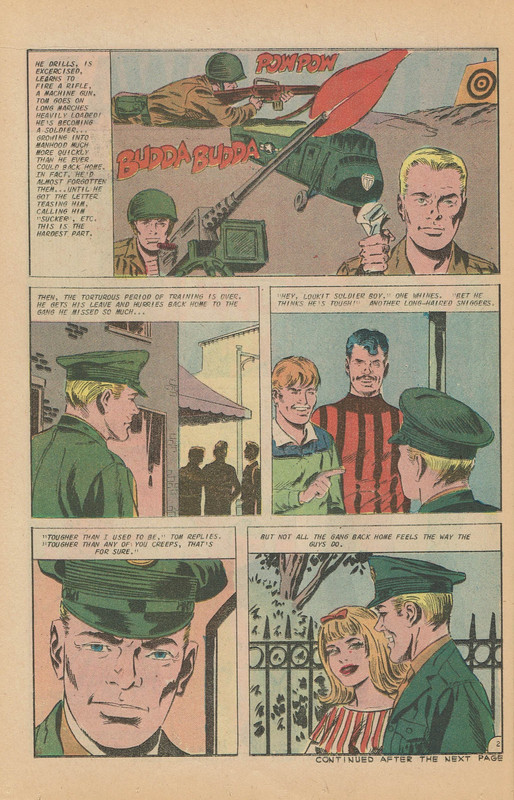
Tom is unsure if the war is just or not, until he lands in Vietnam and sees it first hand and decides it is....
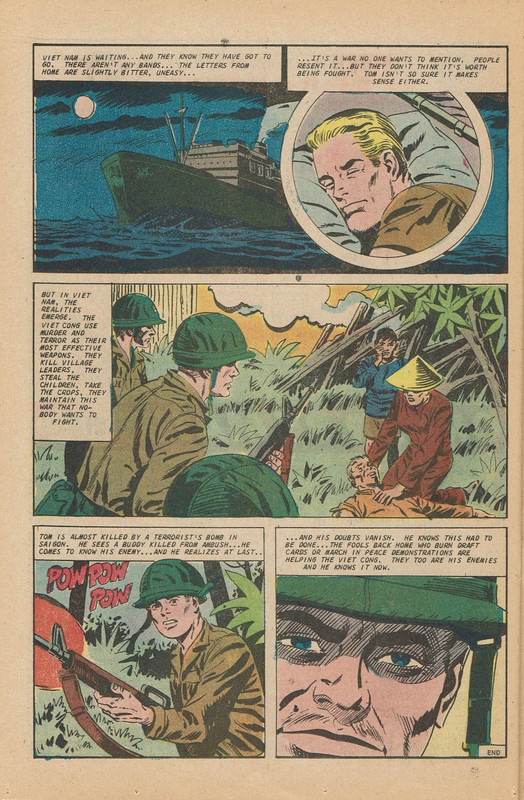
The story ends with the statement, "The fools back home who burn draft cards or march in peace demonstrations are helping the Viet Cong. They too are his enemies and he knows it now."
That's some pretty strong editorializing and it is a decidedly one-sided view of the anti-war movement. In Gill's eyes, anyone who protests the war or doesn't volunteer is either a coward or just too lazy to serve their country and only the VC commit atrocities against civilians. It ignores the First Amendment right to peaceful assembly and to address grievances against the government It ignores protests during the Civil War against the first US draft and those who registered as conscientious objectors in World Wars One and Two, including people like Alvin York, who still served with distinction, or Desmond Doss, who volunteered for service, but refused to take up arms to do so, yet won the Medal of Honor for saving lives and getting wounded men to safety, under heavy fire, after already being decorated for similar actions, in a previous battle.
Service takes on many forms and doesn't necessarily include taking lives, particularly when the war in question has a questionable justification. The Vietnam War was a civil war, between factions that had long rivalries, in which the US and others decided to take a side, based on their own political designs, rather than based on the righteousness of one side's cause over the other. The US willingly supported the Diem government's repression of its own people and engaged in propaganda to prop it up, while the Chinese used Vietnam to advance their sphere of influence in Asia. Ho Chi Minh had turned to the Communists when he was spurned by the US, after being ambivalent about Communist ideology, particularly after the US government sided with France in retaking their former colonies, rather than supporting an independence movement. Ho Chi Minh idolized Washington and the American Revolution; but saw that the US government was more likely to support its white European allies than an Asian populace wanting its freedom and right to self determination.
I was born in late 1966; so, Vietnam was a vague thing, in my life, until it was mostly over. I don't know what it is like to stare at a draft notice and know you are about to be shipped to a war zone. I do know what it is like to be in the military and see news reports that say we are in a shooting war, in the Middle East and have to face a new world, in your job, the next morning. I also know what it is like to see one thing reported by the government in the national media and quite another in secret message traffic. I also saw that US support of an invaded nation did not include a condition of free elections, afterward, to return the unelected government to power. Foreign policy and national ideology are often two very different things.
Vietnam was one of the most contentious times in US history, though not the worst, as the Civil War would have to take top honors for that. The wounds that it created were deep and lasted for a generation and some have never fully healed. Supporting your government when you think it is right is one thing, but knee jerk condemnation of an opposing viewpoint, without even attempting a dialogue, is more akin to fascism than democracy. Sometimes, the best support you can give to the troops is protest the missions they have been tasked to carry out, when they are unjust or murky.
Unlike DC or Marvel, Charlton took a definite editorial stance about the war and fully engaged in telling stories in that setting. DC and Marvel treated it like Korea or WW2, or a Yellow Peril allegory, until it became clear it was not a popular war and it was best not to pick a side, lest they lose readers. They stayed out of it, while DC tried to soften their continuation of war comics, by adding the tag line, "Make War No More." A noble sentiment, though often in contrast with some of the stories they told. It is probably why they stuck to a mostly safe war, in WW2, rather than tell stories about Korea or historically questionable wars, like the Spanish-American War, the Banana Wars, the Mexican War or the Indian Wars. When they did venture into things like the Civil War, it was to demonstrate the tragedy of the fighting, rather than the glory they heaped on the WW2 tales, though even those started showing more the cost of war.
Charlton was a small company, with a limited reach, due mostly to little ambition, other than to keep their presses running. Their comics weren't as widely distributed as DC and Marvel and were less likely to raise protest. Our next subject was an equally small company; but one that wasn't afraid to take a stance. Newxt time, we look at Archie Goodwin's masterpiece, Blazing Combat, particularly the story, "The Land," as we see war, from the enemy's point of view.